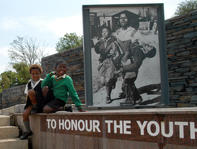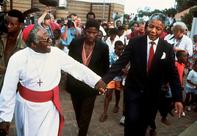Hector Pieterson Memorial
If Sam Nzima, then a photographer for The World newspaper in Joburg hadn't been at the scene when Hector Pieterson was shot, his name would’ve been forgotten by history, like the other children who died during the 1976 Soweto uprising.

Well, do you even know who the other youngsters are in Nzima's famous photograph? The girl is Antoinette Sithole, Hector's older sister; she was 17 at the time and still lives in Soweto. The boy carrying him is Mbuyisa Makhubo; the last his mother heard from him was a letter sent from Nigeria in 1978.
Hector Pieterson may have been the first child killed in the 1976 Soweto uprising, but really he's a symbol for every child who died, and the Hector Pieterson Memorial and Museum in Soweto is dedicated to him and 'all the other young heroes and heroines of our struggle who laid down their lives for freedom, peace and democracy.
Heroes Corner
Heroes' Acre in the Avalon Cemetery in Soweto has been set aside for heroes of the apartheid struggle years. As the years pass it will, sadly, become fuller.
Activists buried in the cemetery include human-rights activist Helen Joseph and Communist Party leader Joe Slovo. If the gravestones continue to be as magnificent as those of Slovo's, which is an upright piece of stone with a hammer and sickle cut out of it, the cemetery will soon be on the international must-do lists.
Soweto Mountain of Hope
Renew your faith in humanity at the Soweto Mountain of Hope or Somoho. The mountain is not a place you go to pray or meditate but to see how a koppie that symbolised the worst kind of city squalor and violence can be transformed into a place of community social and environmental activity.Nobel Laureates
